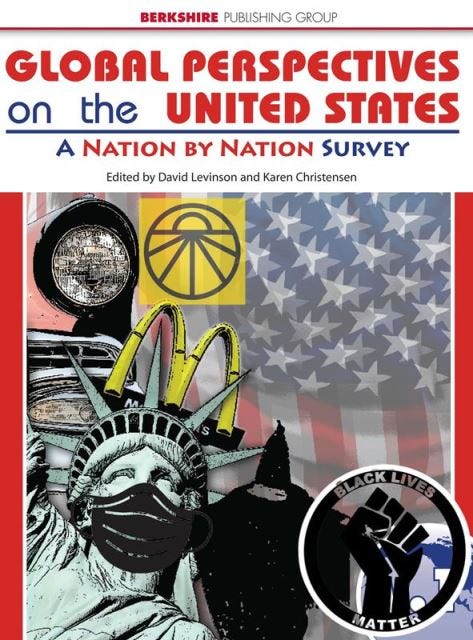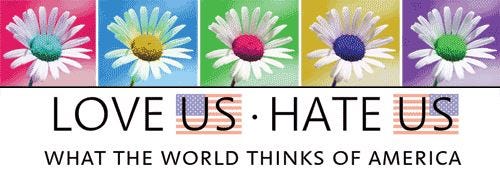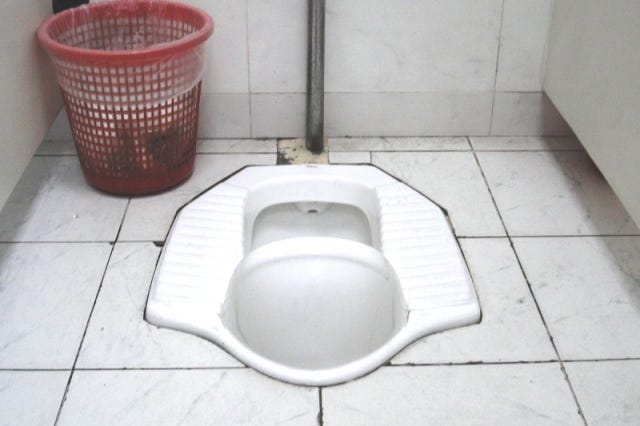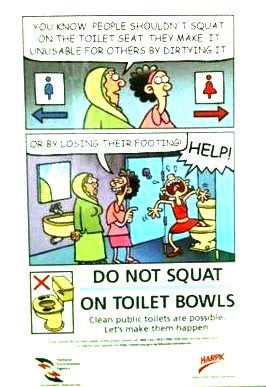How to think globally
A few thoughts on America's role in the world and why we need a new spirit of adventure and imagination.
"The world is too much with us," wrote the English poet William Wordsworth. That seems to be the way a lot of people feel right now.
But thinking globally has never been more important, and we Americans are need to think about how the world sees us after the events of the last few years, and especially the last few weeks.
I love this review of a series I co-edited:
A word of caution – US citizens should prepare to be both revered and insulted. [Global Perspectives on the United States is] not recommended reading for thin-skinned patriots; however, a great resource for academic, public, and high-school libraries.
It reminds me of a line from Frances Trollope’s 1832 Domestic Manners of the Americans:
One of the most remarkable traits in the national character of the Americans . . . [is] their exquisite sensitiveness and soreness respecting everything said or written concerning them . . . Other nations have been called thin-skinned, but the citizens of the Union have, apparently, no skins at all; they wince if a breeze blows over them, unless it be tempered with adulation.
The review of Global Perspectives appeared in Booklist in July 2007, when George W. Bush was president. Innocent times indeed.
In April that year I met a young African textile trader on a train from Hong Kong to Guangzhou. He was enthusiastic about America. “It is God's own country. It is the place of my dreams.” He had watched CNN’s coverage of Hurricane Katrina and was moved by an image of a policeman “rescuing people but, you know, he was weeping because he did not know if his own family was alive or dead.” My seat companion touched his heart, and said, “When you return to your country, please give my greetings to your people.”
Here’s the book cover updated for 2021:
We also published a controversial website called LoveUsHateUS.com. It was hacked by an anti-American group, but it attracted comments from all over the world and generated a lot of discussion. I especially love the design of daisies, based on the children’s game “loves me, loves me not.”
In putting together the books and LoveUsHateUS.com, I learned that while there were many things people disliked about the United States, they also very much wanted for it to stand for something, that the ideals on which the United States was founded were a source of inspiration and hope.
This is relevant right now. The United States was founded with the fundamental aim of making it possible for people with different religious beliefs to live together peacefully and productively. Our founders accepted difference about even such a deeply held and life-determining thing as religious faith.
We can apply this aim of living peacefully together to our neighborhoods and local politics as well as to the national and international issues so much on our minds today. Sometimes things go smoothly and we can simply co-exist. But when we’re trying to resolve conflicts, we need to step outside our own corner and see things from another point of view. That isn’t easy.
We have too many politicians and media figures whose careers depend on dividing us. And it’s a weird fact of modern life that we are less and less likely to know our neighbors and more and more connected to remote acquaintances. This is “community lite,” like sugar-free soft drinks that leave you wanting more, and I think it explains some of modern people’s craving for ideological certainty.
I keep thinking of something Bill McNeill wrote in The Human Web:
Either the gap between cities and villages will somehow be bridged by renegotiating the terms of symbiosis, or differently constructed primary communities will arise to counteract the tangled anonymity of urban life. Religious sects and congregations are the principal candidates for this role. But communities of belief must somehow insulate themselves from unbelievers, and that introduces frictions, or active hostilities, into the cosmopolitan web.
But what does it take to understand someone else’s point of view? “Walk a mile in someone else’s moccasins” is a phrase attributed to various Native American tribes, and I’ll bet many cultures have similar sayings. I think of cross-cultural understanding (which can apply within one’s own country) as coming from embeddedness - living the life, walking the walk, seeing how the world looks from another vantage point.
My latest romance was with an American "Mr. China." When we met in 2007, I was working on the Encyclopedia of China, and for over a decade I had a unique and fascinating vantage point on the country and people I was so much interested in. I spent a great deal of time with Chinese people, entertaining and traveling with them both in the US and in China.
Meanwhile, my son had started life in Beijing. I followed his experiences, and had him as a guide to neighborhood noodle shops and little foot massage places. We went shopping at Carrefour. Ordinary places, familiar daily experiences.
In contrast, my Mr. China had been traveling to China for decades but he had never rented an apartment or bought groceries or just sat in a park. He stayed in hotels. He ate at restaurants. His friends were well-connected and wealthy, or super-wealthy. That jet-setting lifestyle didn’t provide me with the perspective I enjoyed when I just wandered the streets of Beijing or Shanghai. I’m lucky to have had both experiences. Here’s a favorite photo from one of my solitary walks:
My early experience abroad was quite different. I went to England as a teenager, and living and working in London during the Thatcher years was totally immersive. I was young, and I wanted to fit in. My colleagues at Blackwell’s used to laugh because I was the one who trekked four flights down to the basement kitchen to make tea in a pot, instead of using teabags.
It’s easier to become embedded when you’re dealing with similar daily challenges. I had a variety of jobs, belonged to a martial arts club, and helped start a softball league. My children were born on the National Health.
Of course most people don’t have a chance to live abroad, but until the pandemic travel was easy and more affordable than ever before in human history. I’ve known Americans, however, who didn’t want to travel abroad because they were nervous about using another kind of currency. Admittedly, as someone who ran away from home at fourteen, I am probably more adventurous than average. But what really counts is curiosity and imagination, and those are qualities we should be cultivating now because they’ll help us deal with the world that is so very much with us.
I try to use my imagination to see specific things from another point of view. Here’s an example: the Asian toilet, which is so much maligned and a source of fear and anguish to many travelers. An Asian toilet is a ceramic basin set in the floor and extending with a foot rest at each side. One has to squat over the ceramic hole to do one’s business, instead of reclining in what we think of as a civilized way, so comfortable that one can scroll on a phone or read a newspaper. Here’s a nice clean toilet I photographed at the Beijing Book Fair a couple years ago:
Admittedly, using an Asian toilet can be a challenge for the inflexible, and take a bit of practice. But they are anatomically more efficient and use far less water than Western toilets. And while Americans look at Asian toilets as being intrinsically dirtier, that’s really a matter of housekeeping. Try seeing a Western toilet from the point of view of someone who’s never used one. I imagine an Asian woman looking at a seated toilet for the first time and thinking to herself, “What, these Westerners sit on the same seat where the bare flesh of hundreds of other people has been? How disgusting!” It’s a matter of perspective, isn’t it?
Eating to Understand
The most fun way to expand your perspective is simply trying different foods. Exploring new flavors is eye-opening and memorable. School foreign language classes often include cooking and tasting the foods of the language’s home country. I still make a vinaigrette based on the one I was taught by Madame Bosque-Oliver at Monta Vista High School in Cupertino.
But it’s important not to shy away from strange flavors. Marmite, anyone? Fermented tofu? I’ll admit that I found fermented tofu a stretch. I kept trying the stuff, but it tastes like smelly socks. Only last January, when I had a houseful of Chinese guests, did I finally get it, watching how they used a creamy square to flavor a bowl of lunchtime rice. Now I add a bit to my morning congee (zhou) - it adds just the right salty, umami kick.
This applies at home, too. Remember Obama and Arugula-gate? Sure, less cosmopolitan folk might not eat arugula or pesto, but they shouldn’t feel we despise them because of something like that. I’ve been trying some of my Iowa grandmother’s recipes - they’re plain, but really delicious. Now I’m ready to entertain not only Chinese guests but visitors from the Middle West.
Different Perspectives on a Green Deal
Since we’re on a political tack this week I want to mention the US “Green New Deal.” I’ve been reading a lot of legislation lately because of the Train Campaign, and even helped write some. With Joe Biden taking office next week, I’ve been thinking about what the Green New Deal should be.
This bill, submitted in 2019 by a new congresswomen with support from a veteran Massachusetts senator, has had a lot of attention. The name is a play on President Roosevelt’s New Deal in the 1930s. You can take a look at the actual bill here. (The old-fashioned fonts are a hoot.)
It’s only 14 pages, more a statement of grand objectives and promises than a document that can be acted on. My big concern is that it’s an insular, nationalistic document about a subject that requires the best of global thinking. The drafters didn’t seem to realize that you can’t plan for the future without taking the rest of the world into account. The Brookings Institution projected in 2019 that global middle-class consumption would nearly double by 2030, from $34.9 trillion to $63.9 trillion. Only $1 trillion of that increase was expected to take place in advanced economies. Eighty-eight percent of the increase would come from Asia. This is going to put massive pressure on the environment, even if the timing is changed by the pandemic.
A new report from the EU addresses the challenge in a different way, asking if we can have “Growth without economic growth”? I look forward to talking more about this in the weeks ahead.
Podcast from Washington DC
On Wednesday morning I recorded a podcast interview with Congressman Seth Moulton shortly before he was due to vote on the second impeachment of Donald Trump. The podcast is a little shorter than our usual programs (only 16 minutes) because Moulton and his aide were delayed by the increased security in Washington, but he wanted to keep to our schedule and talk about trains and the future, in spite of the huge distractions of the moment. (Keep in mind that he was at the US Capitol a week earlier, on January 6th, when it was attacked.) You can listen to “A Bold Vision for High-speed Rail in the US” by clicking here.
PS: In response to last week’s letter, I really appreciated hearing from people who are also concerned about family members who have been caught up in right-wing mythologies. At home, we’ve been talking about millenarian thinking and cult de-programming. But the good news is that I’m more connected to my other siblings and my mother than I’ve been in many years. We plan to be together via Zoom for the inauguration.










